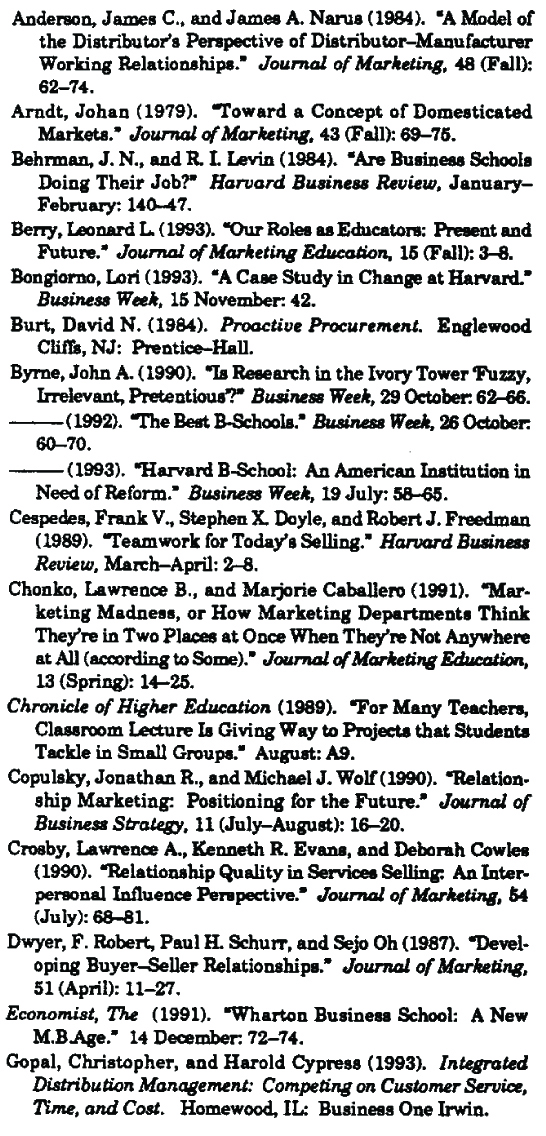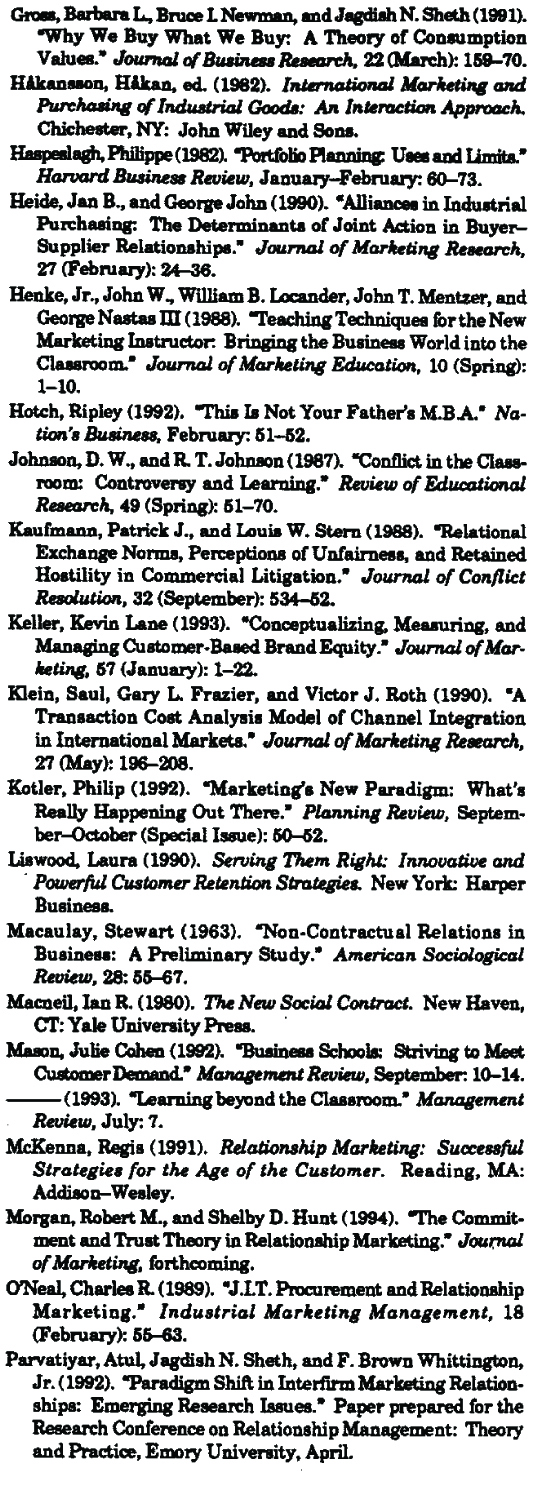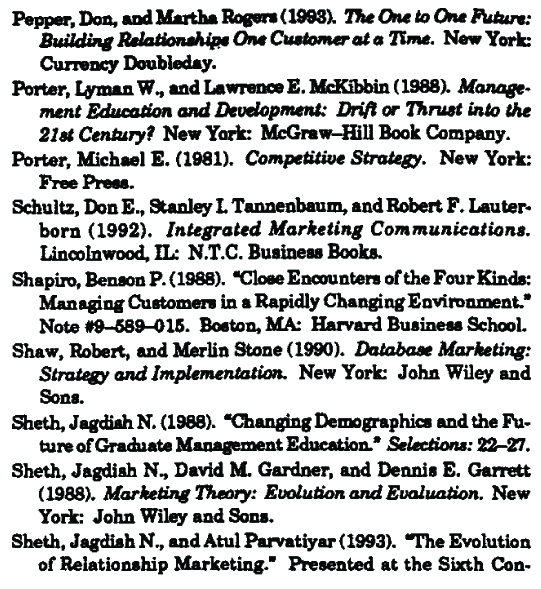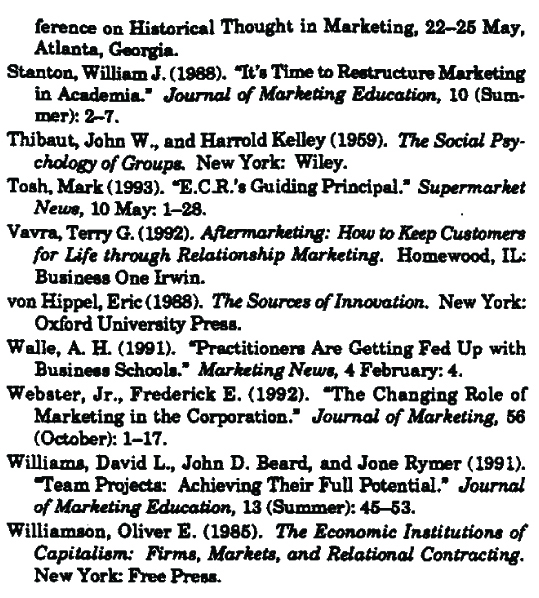Joseph P. Cannon and Jagdish N. Sheth | Criticism of the relevance and process of business school education and research continues to mount. At the same time, academics and practitioners have become increasingly dissatisfied with traditional marketing theory and practice—with growing importance being placed on relationship marketing. This article describes a new MBA curriculum developed by the faculty at Emory Business School at Emory University, designed to meet the needs of students, faculty, and the business community.
Business schools have increasingly become targets of criticism from students and the business community. These criticisms have focused on curriculum content (Byrne 1993; Mason 1992; Porter and McKibbin 1988; Sheth 1988), teaching methods and pedagogy (Hatch 1992), and the relevance of academic research (Behrman and Levin 1984; Byrne 1990; Stanton 1988; Walle 1991). In response to these criticisms, many business schools have radically changed their curriculum (Bongiorno 1993; Byrne 1992; Mason 1993).
During this same time period, a rapidly changing competitive environment, the total quality management (TQM) movement, advances in information technology, and increasing globalization of industries have changed the way firms market their products. Many firms are changing their attention from single-mindedly acquiring new customers to placing greater focus on retaining current customers (Liswood 1990; Vavra 1992). These trends point to the emergence of a new paradigm or school of marketing thought — relationship marketing (Kotler 1992; McKenna 1991; Parvatiyar, Sheth, and Whittington, Jr. 1992; Sheth, Gardner, and Garrett 1988).
The purpose of this article is to describe an innovative curriculum being developed at the Emory Business School at Emory University. The curriculum at Emory is being revised to address the concerns of its customers (students and business) and to place a greater emphasis on relationship marketing. The enhanced curriculum and supporting structures create a three- way partnership between students, faculty, and the business community. These changes create an environment that enhances the relevance and quality of teaching and research in relations hip marketing.
The article begins by briefly expanding upon the criticisms of teaching and research in graduate management education. The second section describes and discusses relationship marketing. Given the shortcommings of current business education and the emergence of relationship marketing, we develop a set of objectives governing curriculum development. These are elaborated in the third section. A description of the proposed curriculum and its supporting structures follows. The last section discusses the implications of the program for students, faculty, the business school, and business practice, then proposes directions for future development.
Criticisms of Business Schools
Business schools have come under attack for failing to teach students the subject matter and skills needed to be effective managers and for spending too much time conducting “fuzzy” and/or “Irrelevant” research (Byrne 1990). Critic lam of the education and research provided by graduate business schools falls into three general categories (see Exhibit). Some have criticized the content of management education, noting the lag in bringing leading edge management practices to the classroom (Byrne 1990; Hotch 1992) and failure to focus on the cross- functional nature of business practice (Mason 1992; Sheth 1988). Others indict the pedagogy or process of management education. Typical teaching methods have not helped students develop requisite shills (Byrne 1993) or provided students with adequate real world experiences (Hotch 1992).
Besides knowledge dissemination, a key role for faculty is to develop knowledge relevant for managers (Berry 1993). Yet business school research does not tackle problems important and relevant to today’s manager (Byrne 1990; Chonko and Caballero 1991; Stanton 1988). Furthermore, relevant research takes too long to get into the classroom (Economist 1991). The lengthy journal review and publication process means that research conceptualized and conducted now may not be in print for two to three years, or more. It might take two more years before such findings make it into textbooks.
The criticism outlined in this section suggest that business schools need to balance research and education among three criteria: relevance, process and rigor. Managers (current and future) require faculty to provide them with knowledge that is relevant and able to guide their decisions. Students desire that the pedagogy help them to develop skills and provide them with hands-on experience. Faculty value research and education that is rigorous and. therefore, valid. The criticisms of business and marketing education outlined above suggest that in some ways we have gotten away from these criteria. The following section describes how relationship marketing provides a relevant umbrella for our curriculum.
Relationship Marketing
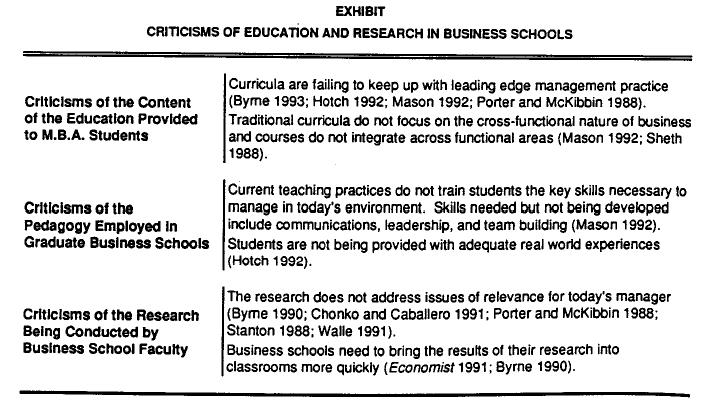
The development of marketing theory and practice is undergoing a paradigm shift from a transactional to a relationship orientation (Arndt 1979; Dwyer, Schurr, and Oh 1987; Kotler 1992; McKenna 1991; Sheth, Gardner and Garrett 1988). The curriculum described below places a great emphasis on the role of marketing in building and managing relationships with a company’s many stakeholders, which could include suppliers, competitors, governments, and employees, as well as customers (Morgan and Hunt 1994; Webster Jr. 1992). This section briefly describes the emergence of relationship marketing in marketing research and practice.
Relationship marketing reflects a strategy and process that integrates customers, suppliers, and other partners into the company’s design, development, manufacturing, and sales processes (Sheth and Parvatiyar 1993). Relationship marketing emerged from dissatisfaction with existing paradigms. In evaluating different schools of marketing thought, Sheth, Gardner and Garrett (1988) suggest the need to focus on ongoing, collaborative “exchange that creates value (win-win) for both parties (see Figure 1). Indeed, many marketing theories tend to focus on exchange as ad hoc transactions, based on conflict (zero—sum, win—lose).
Observing that theory does not match up with current practice, the orientation of academic research in marketing has begun to place greater attention on ongoing relationships. Drawing on theories from economics (for example, transaction cost analysis, Williamson 1985), social psychology (for example, social exchange Theory Thibaut and Kelley 1957), sociology (Macaulay 1963), and law (for example, relational contracting, Macneil 1980), many marketing scholars have started to focus their attention on ongoing buyer-seller relationships (Anderson and Narus 1984; Arndt 1979; Crosby, Evans, and Cowles 1990; Dwyer, Schurr and Oh 1987; Hskansson 1982; Heide and John 1990; Kaufmann and Stern 1988).
The practice of relationship marketing is spreading across many markets and industries. Manufacturing organizations build closer relationships with their suppliers to better manage total quality and inventory costs and to facilitate new product development (Burt 1984; O’Neal 1989; von Hippel 1988). Several packaged goods firms have built closer relationships with retailers to mutually reduce costs and increase sales (Tosh 1993). Many organizations are now seeking methods for building closer relationships with consumers through managing brand equity (Keller 1993) and database marketing (Copulsky and Wolf 1990; Shaw and Stone 1990)- Firms are discovering that directing more marketing resources toward consumer retention (as opposed to acquisition) may prove more efficient (Liswood 1990).
Practicing relationship marketing requires a different set of skills and tools. For example, personal selling traditionally involves identifying prospects, persuading them of the benefits of your product or service, handling objections, and closing the sale. Relational selling requires a salesperson to build trust and to teach, as well as learn form, customers (Shapiro 1988). With consumers, one builds databases with information about consumer needs and preferences, ultimately developing an ongoing dialogue (Pepper and Rogers 1993)- Consumers benefit from customized products and services. Relationship marketing changes the way a firm looks at other marketing mix elements as well. Customer service gains new importance and customer satisfaction becomes an increasingly important measure of marketing effectiveness.
We are still learning a great deal about the theory and practice of relationship marketing. The emerging paradigm promises to redefine marketing practice and the role of marketing in the firm (Webster 1992). The curriculum and supporting structures outlined below are designed to synergistically enhance research and thing of relationship marketing.
Objectives for a New Curriculum: Enhancing Exchange Relationships among Students, Faculty, and Business
The business school critics cited above suggest three areas for improvement. Interestingly, each of these areas represents a key interest for each of the main stakeholders of business schools—students, the business community, and faculty Students have the most to gain from improving the teaching process—the way that we disseminate knowledge. The business community seeks to influence teaching and research into topic relevant to today’s marketing manager. Finally, faculty seek to maintain sufficient rigor to assure the validity of new knowledge.
In developing a new curriculum, our overarching goal is to enhance the value of the exchanges between each of the parties. We have sought to balance the main desires of each of these parties by focusing on developing a curriculum that addresses both teaching and research while emphasizing relevance, process, and rigor In addition, the emerging relationship marketing paradigm suggests an area where students, faculty and business can benefit from the development and dissemination of new knowledge. The following were the primary objectives in developing the new curriculum.
1) Relationship marketing must be a theme that runs through all of the classes in the new curriculum. Although not abandoning the critical role of marketing in acquiring new customers, a new curriculum must place a greater emphasis on the role of marketing in retaining current customers through relationship marketing.
2) Individual courses and support structures should foster increased student and faculty linkages with the business community to provide more opportunities to study and solve real world problems.
3) To enhance the value and timeliness of the educational product being delivered, the curriculum must create opportunities for faculty to bring the most recent research findings into the classroom.
4) The curriculum must provide students with many opportunities to build and develop their leadership, team building, and communication skills.
The Program: Curriculum and Support Structures
Addressing the objectives outlined above necessitated changes in pedagogy, course content, and the development of supporting structures. This section begins by describing the specific marketing courses that make up the e of the curriculum development. Next, we discuss changes to the pedagogy that cut across most of the courses. The last subsection explains the role of two supporting structures, the student-run Emory Marketing Association and the Center for Relationship Marketing.
Marketing Courses
Developing a new curriculum requires modifications to or elimination of existing courses and the development of new course.. Decisions on changes to course content reflect the need to place greater emphasis on relations hip marketing. These changes resulted in the 17 courses represented graphically by the Wheel of Relationship Marketing in Figure 2. At the hub of the wheel is our core course—Marketing Management. The first ring around the core are secondary level courses that deal with key marketing skills. These first ring courses have titles familiar to many marketing curriculums, but each focuses attention on the role of relations hip marketing in building and managing relationships with key constituencies. The outer ring courses are more advanced electives that focus on developing and implementing relations hip marketing strategies.
This section is organized by moving around the Wheel of Relationship Marketing. We begin with Marketing Management, then move clockwise around the first ring courses, and finally the outer ring courses. Although many of the courses described below are up and running, others are currently being developed.
Marketing Management A Relationship Perspective. This is the core and introductory course in the marketing curriculum. As with traditional courses of this type, this class introduces students to concepts and principles of marketing management and develops their skills in analyzing marketing issues. During the first week of class, students are exposed to the basic principles of relationship marketing. The class discusses conditions where relationship strategies are most appropriate. As concepts regarding situation analysis, the marketing mix, and marketing strategy are presented, we highlight differences between relationship and transactional orientations. While discussing marketing communications with current customers receive as much attention as communications with prospective customers (Vavra 1992). Differences between the message, media, and measures used in these types of communications are discussed as well. Students also spend a week specifically examining relationship marketing and its application and implementation in consumer and business markets.
Marketing Research. Marketing Research teaches students methods for collecting, analyzing, and interpreting data relevant to managerial decision making. Yet different research questions and methodologies are employed when the goal is customer retention, as opposed to acquisition. Since both of these topics are essential for today’s manager, this course identifies research techniques appropriate for each objective. For example, ignite time is spent with the complex but important issues of measuring customer satisfaction and brand equity.
Customer Behavior. Customer Behavior reflects more than a name change to the traditional Consumer Behavior course. This course emphasizes that marketplace choices are made by a broad spectrum of internal and external customers. Customer Behavior examines the behavior of different types of customers—consumers, businesses, resellers, and governments—as well as suppliers, employees, stockholders, and other stakeholders of the firm. The course develops a common framework based on the values that influence their market choices (Gross, Newman, and Sheth 1991). The course, which makes the assumption that customer satisfaction provides a critical source of sustainable competitive advantage, helps students determine the sources of satisfaction for various types of customers.
International Marketing. Besides the traditional four Pa, international marketing adds two more Ps: government policy and public opinion processes. Firms must develop relations hips with suppliers, customers, competitors, and governments. The more dynamic and complex environment for international commerce increases the need for firms to develop closer relationships (Klein, Frazier, and Roth 1990). Closer buyer-seller relationship are a method for managing and reducing uncertainty, but, on the other hand, cultural differences can hinder relationship building. Therefore, this course teaches the mechanics involved in developing, managing, and maintaining relationships across cultural boundaries.
Marketing Strategy. This course builds on the Marketing Management course and emphasizes the development and implementation of marketing plans. The course provides the students with a better understanding of marketing strategy through examining the evolution of strategy. The last two decades have seen a number of frameworks: strategic planning, portfolio models (Haspeslagh 1982), and Porter’s model (1981). This course reviews these frameworks and develops a relationship framework that focuses on using relationships with suppliers, distributor, competitors, and customers to build a sustainable competitive advantage. Customer analysis is a key issue that looks at assessing a firm’s customer mix and strategies for retention and deletion.
Foundations of Relationship Marketing. This course is an introduction to the emerging relationship marketing paradigm. The course brings together skills essential to the practice of relationship marketing and discusses their application to building and maintaining both inter- and intraorganizational relationship. The course integrates student learning on total quality management (TQM), information technology, team building, theories and concepts of cooperation, and project management, and demonstrates how these concepts apply to building and managing relationships.
Measuring Customer Satisfaction. Building on what students learn in Marketing Research, Measuring Customer Satisfaction is a minicourse (one-third or one-half semester long) that focuses on evaluating customer satisfaction. Keeping close tabs on customer satisfaction is key to customer retention. Currently, many organizations are struggling with developing customer satisfaction measures that can be used to compensate salespeople, evaluate managers, and assess changes in marketing strategy This course will introduce students to the theories and methodologies used by organizations attempting to measure the level of satisfaction of their various customer groups. The assessment of satisfaction trends and effects of particular interventions will also be discussed. By comparing and evaluating methods used by different firms in different industries, students axe expected to gain an appreciation of the import ance and complexity of assessing customer satisfaction.
Database Marketing. Advances in computing power and database management (for example, scanner data and direct marketing databases) create unique analytical and Strategic opportunities for marketing managers (Shaw and Stone 1990). These databases allow organizations to efficiently build, manage, and evaluate relationships with individual consumers (Schultz, Tannenbaum, and Lauterborn 1992; Pepper and Rogers 1993). This course presents methods for building, managing, and analyzing databases for sustainable competitive advantage.
Key Account Management For many companies, the old 80:20 rule is no longer valid. For many firms, less than 5% of a firm’s customers provide over 90% of their business. Further, principles of total quality management (TQM), ISO 9000, supply chain management, and process reengineering (when the process includes customers) demand that firms build and maintain closer relationships with fewer customers and suppliers. These realities require firms to develop new sales and purchasing tactics. Team selling (Cespedes, Doyle, and Freedman 1989) may require a salesperson to work with cross-functional teams from the buyer and seller developing custom systems to maximize the efficiency and effectiveness of exchange. This minicourse requires students to interact with local businesses to learn and assess how these firms manage their interactions with key aunts.
Integrated Distribution Management. The focus of this course is on supply chain management, including aspects of purchasing, manufacturing, logistics, customer service, and relations with other channel members. Advances in information technology allow for increased integration across these functions to allow the order cycle to be managed as a single process. This allows a firm to compete on key attributes of customer service, time, and cost (Gopal and Cypress 1993). Methods for managing the intra- and interorganizational relationship necessary to make this process work effectively is the focus of the course.
Direct Marketing. Building relationships with smaller sales volume customers requires firms to employ direct marketing techniques. Through the creative use of databases, tale- marketing, direct mail, and direct sales, many firms are finding low-cost methods for building and maintaining relationships with customers. This minicourse exposes students to strategies and tactics necessary to successfully employ direct marketing for the purpose of building closer customer relationships.
Global Sourcing. A recent trend in business to focus on core competence. This has lead many firms to outsource not only manufacturing, but also services (for example, data management) and personnel. Some firms are finding that firms or employees in other countries are more effective or efficient. Procuring these services leads to long-term commitments and unique relationship management needs. This minicourse examines this trend and discusses methods for managing these external sourcing relationships under across-cultural and cross-national context.
Global Alliances. Most business schools are placing an increasing emphasis on their international offerings. As noted above, the complexity and dynamics of the international marketplace require closer relationship, but cultural differences complicate their management This course allows students interested in the international arena to further .min5 these issue& The nature o(the course might allow for codevelopment or team teaching with faculty in the policy area.
Integrated Marketing Communications. Integrated marketing communications (EMC) recognizes that mass advertising by itself does not seem to work (Schultz, Tannenbaum, and Lauterborn 1992). IMC takes a customer- focused view to see how customers learn about products and services. This course looks beyond advertising and personal selling and examines controllable (for example, direct marketing, customer service. and packaging) and uncontrollable (for example, word of mouth, competitive activities, and retail merchandising) communications. INC manages these communications sources under one umbrella to present a unified message. INC also emphasizes the importance of using communications to develop a dialogue with customers to enhance the development and management of customer relationships.
Marketing Planning and implementation This advanced level elective would focus on the cross-functional requirements necessary to implement a marketing strategy. The success of a marketing strategy requires close relationships and integration across functional areas. This course would expose students to the need for cooperation and collaboration with other functional areas and suggest methods for enhancing the ability to implement marketing strategies.
Customer Business De elopement Track. This course provides an educational experience that is unique in both content and process and represents a new model for business education. The course examines a number of key issues important to developing, managing, and maintaining relationships with business customers, including developing information systems, determining how to utilize multifunctional resource. to support a customer strategy and managing the change to a new method of selling.
The process of the course is also unique. The first phase begins with summer internship at one of the sponsoring companies. Students interview internships that allow each of them to work in the marketing area of one of the companies. The summer internship is monitored and supported by a faculty member. This interaction not only assures that the students experience is meaningful, but also allows the faculty member to gain contacts and insight into current practice. The faculty member may discover potential research topics and research sites.
The process continues into the fall through a symposium series. The symposium brings the students, cross-disciplinary faculty, and executives of sponsoring companies together to discuss the topics outlined above. Preparation involves reading key articles dealing with the day’s topic. Each of the parties shares their ideas and experience relative to the day’s readings, under the guidance of a lead faculty member. The three-way partnership that drives the course is designed to ensure that the issues and research discussed are timely.
Internal Relationship. An important type of relationship occurs within the firm. The nature of these internal relationship, is critical to the competitive effectiveness clan organization and its ability to develop external relationships. This includes the concept of internal marketing, but goes beyond relationships between employees. The course in internal relationships would include relationship. between divisions, functional units, or revenue centers (such as marketing and sales).
Pedagogy
The courses outlined in the previous section are taught using many of the traditional methods, including mixes of cases, text, and outside readings; simulations; lectures; and classroom discussion. A number of educators have cited the benefits of group learning (Chronicle of Higher Education 1989-, Johnson and Johns on 1987; Williams, Beard, and Rymer 1991). One of the objectives of the curriculum described above is to enhance students’ teamwork, communications, and leadership skills. Group projects offer a method for advancing student shills in each of these areas. Working in teams simulates work groups, which are becoming an increasingly common business practice (Cespedes, Doyle, and Freedman 1989; Williams, Beard, and Rymer 1991). Group interaction, as well as writing and presenting the results of such a project, enhances students’ communication skills (Henke St 51. 1988). Fin ally, effective group work requires students to assume particular roles and practice leadership skills.
A second objective clout curriculum is to enhance student and faculty relationships with the business community and foster study of real world issues. Many of the group projects involve students working with local businesses. Field projects in Marketing Management have included designing a marketing communications program for a community recycling center and developing marketing plans for several local charitable organizations. International Marketing requires students to write a case on an international marketing problem at a real company. The Marketing Research course employs field projects where students perform research for nonprofit organizations. These activities enhance the school’s legitimacy within the community More than one o(these field projects has led to faculty research.
Another pedagogical tool that has been introduced to the curriculum is team teaching. Many of the courses employ team teaching techniques, either with other marketing faculty or by employing expertise that exists in another functional area.
Supporting Structures
Two additional organizations support and enhance exchange relationships among students, faculty and business. The Emory Marketing Association and the Center for Relationship Marketing complement and help to integrate the changes to the curriculum, and both provide field experience for students to enhance the principle learned in class.
Emory Marketing Association. The Emory Marketing Association is a student-run organization that enhances the overall marketing education of Emory Business School students. The Association does this by providing opportunities for experiential learning through greater interaction with faculty and the business community. This ii accomplished by sponsoring speakers, faculty-student mixers, and a movement—the Marketing Competition.
For the Marketing Competition, sponsoring companies pay a participation fee and provide a marketing-related challenge to be solved by teams of students. The student teams develop and carry out research proposals in conjunction with faculty and their sponsoring company. Student groups work on the projects for several months, with the process culminating in competitive presentations. Executives of the sponsoring companies and the faculty judge the projects, and the winning teams receive cash prizes.
Center for Relationship Marketing. The Center for Relationship Marketing has been created as an interdisciplinary hub for coordinating and managing a full range of research and education activities designed to create and disseminate breakthrough knowledge of relations hip marketing principles arid practices. The Center ii also designed as a prototype for a new model of business research and education that incorporates a three-way partnership process between business, faculty, and students as the core of all Center activities. This partnership concept represents a relationship approach to concurrent knowledge engineering that fuses together the historically disparate strands of scholarly research, teaching students, and the broader dissemination of new learning to the business community.
The innovative Customer Business Development Track specialization in the M.B.A. program (described above) has established the three-way partnership between business, faculty, and students to provide value-added in education. This program will be housed in the Center and its underlying partnership model is currently being extended to include basic and applied research.
The Center is currently undertaking an international benchmarking study of “best practices” methods of relationship marketing, which will provide scholars with a rich source of primary data to analyse. It will also provide guidance to industry regarding which relations hip marketing practices are most effective in enhancing organizational performance. In addition, the Center funds support for Ph.D. dissertations and faculty research that focus on relationship marketing issue.. It is hosting the American Marketing Association’s Faculty Consortium on Relationship Marketing in June 1994. Every two years the Center also sponsors a research conference on relationship marketing that draws academic scholars and professional researchers from around the world to share their latest research on the subject.
Discussion
The curriculum described in this article is still evolving and is being implemented gradually. Significant change does not come easily in any organizational setting. This section begins with a discussion of challenges that may face a school attempting to implement this curriculum and the situations where implementation may be most successful. The discussion section concludes by describing how the curriculum may be modified for an undergraduate program.
Implementing the Relationship Marketing Curriculum
Implementing the relationship marketing curriculum described in this article requires good working relationships among the marketing faculty, across other disciplines, with the school’s administration, and with the business community. Thus far, we have benefited by having a group of faculty who share a common world view” and believe in relationship marketing as an emerging school of thought. Our shared vision allows us to more easily agree on a new direction. We expect that schools with more diverse opinions regarding pedagogical emphasis and the most appropriate marketing paradigm will have greater difficulty implementing the curriculum we suggest.
Gaining faculty cooperation critical to the success of the new curriculum. The changes in course content will require many faculty members to completely revise well-developed course preparations. The new courses often have no precedents, models, or textbooks to follow. Faculty members must invest time researching the topic and preparing a new course. Further, since relationship marketing concepts are not well understood, faculty must stay current on theory and practice and be prepared to constantly update course content to reflect the latest thinking. Finally, courses involving fieldwork may place additional burdens on faculty members to manage the logistics of contact with local business organizations. Making these changes may be particularly challenging in a school that does not place a high value on teaching relative to research.
Many of the classes will require cooperation and coordination with other disciplines in the school. For example, the Foundations of Relationship Marketing course employs guest faculty from Management to discuss team building, from Operations to discuss total quality management and information systems, and from accounting to discuss activity-based costing. Because many of the more advanced elective classes require knowledge acquired in other disciplines, we must be aware of the content of courses in other areas.
Another challenge for many schools will be developing appropriate linkages with the business munity Student internships and executive participation in the symposium are key aspects of the Customer Business Development Track. For businesses to make this kind of commitment, they must have confidence in the school and its students and be convinced of the value of relationship marketing.
With the curriculum being focused more heavily on relationship marketing, our faculty had to decide what aspects of marketing required less emphasis. We chose to place less emphasis on courses that dealt with the traditional elements of the marketing mix. Therefore, the curriculum does not include many traditional marketing courses in advertising sales management, pricing, and product management. This is not to say that these elements of the marketing mix are not included in other courses, rather that they were given less attention by making them parts of other courses. In replacing a traditional Consumer Behavior course with Customer Behavior, we provide students with a broadened perspective of customer at the expense of the in-depth analysis of consumers. These tradeoffs were consciously made, and we chose to limit the depth in areas where students were likely to receive additional training and knowledge in a first job.
Adapting the Curriculum to an Undergraduate Program
Although our emphasis has been on describing our curriculum for the M.B.A. program, we plan to include many of these courses in the undergraduate program. Many of the courses focus on basic tools that have equal application to undergraduate education. This is particularly true for Marketing Management (Principles in the undergraduate class), Customer Behavior, Marketing Research, Marketing Strategy and International Marketing.
On the other hand, some of the courses are specifically designed to prepare students for more advanced positions, and we do not have plans to offer Key Aunt Management or Global Alliances to the undergraduates. Finally, the Customer Business Development internship and symposium appeals to companies looking to hire and benefit from advanced students. This type of program may be possible at a school with an established internship program and strong links with the business community.
Conclusions
Many of the criticisms being directed at business schools today are valid. These represent comments from our key customers— students and the business community—and they should not be ignored. The failure of many business schools to address these criticisms is causing a growing number of our customers to reassess the value of graduate business education.
Emory Business Schools marketing area seeks to simultaneously increase the school’s value to the students, faculty, and the business community. This goal is being addressed through the establishment o(a new curriculum and associated structures that provide a program bringing rigor and relevance to both teething and research.
The program described here is in a state of evolution. Rapidly changing technology and competition do not allow any organization to sit still. The TQM philosophy suggests that we need to emphasize concurrent knowledge engineering, whereby we constantly improve our educational offerings to reflect the latest thinking, technology and practice. The curriculum has been designed to allow fir evolution. This is primarily accomplished through the flexible outer ring courses and the close relationships the marketing area has with students and practitioners
References
